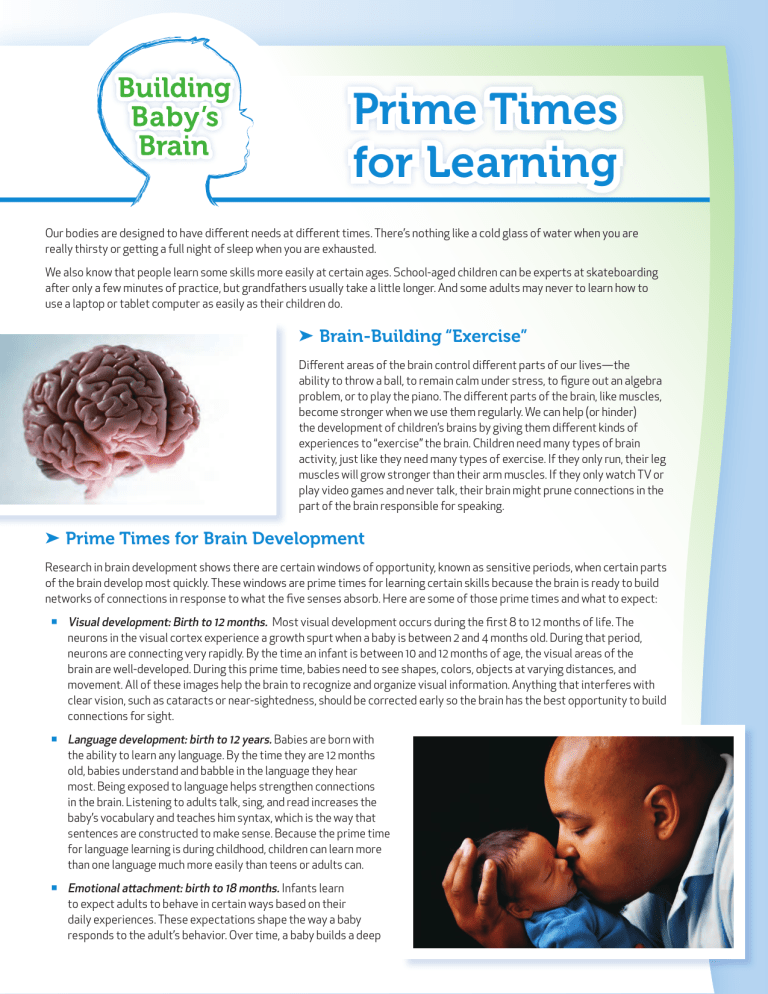Prime Times for Learning

Prime Times for Learning
Our bodies are designed to have different needs at different times. There’s nothing like a cold glass of water when you are really thirsty or getting a full night of sleep when you are exhausted.
We also know that people learn some skills more easily at certain ages. School-aged children can be experts at skateboarding after only a few minutes of practice, but grandfathers usually take a little longer. And some adults may never to learn how to use a laptop or tablet computer as easily as their children do.
➤
Brain-Building “Exercise”
Different areas of the brain control different parts of our lives—the ability to throw a ball, to remain calm under stress, to figure out an algebra problem, or to play the piano. The different parts of the brain, like muscles, become stronger when we use them regularly. We can help (or hinder) the development of children’s brains by giving them different kinds of experiences to “exercise” the brain. Children need many types of brain activity, just like they need many types of exercise. If they only run, their leg muscles will grow stronger than their arm muscles. If they only watch TV or play video games and never talk, their brain might prune connections in the part of the brain responsible for speaking.
➤
Prime Times for Brain Development
Research in brain development shows there are certain windows of opportunity, known as sensitive periods, when certain parts of the brain develop most quickly. These windows are prime times for learning certain skills because the brain is ready to build networks of connections in response to what the five senses absorb. Here are some of those prime times and what to expect:
Visual development: Birth to 12 months. Most visual development occurs during the first 8 to 12 months of life. The neurons in the visual cortex experience a growth spurt when a baby is between 2 and 4 months old. During that period, neurons are connecting very rapidly. By the time an infant is between 10 and 12 months of age, the visual areas of the brain are well-developed. During this prime time, babies need to see shapes, colors, objects at varying distances, and movement. All of these images help the brain to recognize and organize visual information. Anything that interferes with clear vision, such as cataracts or near-sightedness, should be corrected early so the brain has the best opportunity to build connections for sight.
Language development: birth to 12 years. Babies are born with the ability to learn any language. By the time they are 12 months old, babies understand and babble in the language they hear most. Being exposed to language helps strengthen connections in the brain. Listening to adults talk, sing, and read increases the baby’s vocabulary and teaches him syntax, which is the way that sentences are constructed to make sense. Because the prime time for language learning is during childhood, children can learn more than one language much more easily than teens or adults can.
Emotional attachment: birth to 18 months. Infants learn to expect adults to behave in certain ways based on their daily experiences. These expectations shape the way a baby responds to the adult’s behavior. Over time, a baby builds a deep
attachment relationship with important adults in her life. Early attachments teach the child what to expect in future relationships and influence the way the child forms relationships throughout life. Infants whose adults are reliable and nurturing learn to trust adults to take care of them. This trust is the foundation of a secure attachment. Children whose caregivers are unresponsive or inconsistent learn that adults are unreliable. As a result, they tend to form insecure attachments.
Sensory development: birth to 18 months. Sensory abilities develop early. Babies are born with basic sensory abilities such hearing, taste, and touch. With repeated experience, the brain connections that process sensory information become more complex. Most sensory abilities are completely developed within the first 12 to 18 months of life. Development of the senses is biologically driven, but experience is required for them to develop normally. A baby who does not have specific sensory experiences cannot make and strengthen connections for those abilities.
Without continued exposure to the same experiences, the brain will eventually prune some of those connections.
➤
What Can You Do?
Here are some ways adults can help babies get the experiences they need during prime times for learning:
Remember that early experiences matter. Expose children to new people, places, and things, beginning when they are very young.
Repeat, repeat, repeat. Repeating the same activities over and over actually strengthens connections in the brain.
Talk, read, and sing with your baby. These early experiences help strengthen language and build secure attachment.
Keep in mind that everything is new to a baby. New experiences don’t have to be expensive or difficult. A walk in the park or a chance to play with the pots and pans in the kitchen can be great sensory experiences.
Don’t overwhelm the baby. Like adults, babies need a little quiet time to process what they are learning before they are ready to do something new.
Selected References:
Bales, D. W., Falen, K., Butler, T., Marshall, L. E., Searle, L., & Semple, P. (2012). Better Brains for Babies Trainer’s Guide, (2nd ed.).
Fox, A., Leavitt, L. A., & Warhol, J. G. (1999). The role of early experience in infant development (pp. 69-82). Calverton, NY: Johnson &
Johnson Pediatric Institute.
National Scientific Council on the Developing Child. (2007). The timing and quality of early experiences combine to shape brain architecture: Working paper no. 5 . Retrieved from http://developingchild.harvard.edu/index.php/resources/reports_and_working_ papers/working_papers/wp5/.
Shonkoff, J. P., & Phillips, D. A. (Eds.). (2000). From neurons to neighborhoods: The science of early childhood development . Washington,
DC: National Academy Press.
Zimmerman, F. J., Gilkerson, J., Richards, J. A., Christakis, D. A., Xu, D., Gray, S., & Yapanel, U. (2009). Teaching by listening: The importance of adult-child conversations to language development . Pediatrics, 124(1), 342-349.
For more information about brain development, visit www.bbbgeorgia.org
www.fcs.uga.edu/extension Circular 1053-02.
Revised August 2014.
Written by: Dr. Diane Bales, Associate Professor and Extension Human Development Specialist
Supported by the University of Georgia College of Family and Consumer Sciences “Strengthening Georgia Families and Communities” Initiative. The University of Georgia, Fort
Valley State University, the U.S. Department of Agriculture and counties of the state cooperating. UGA Extension offers educational programs, assistance and materials to all people without regard to race, color, national origin, age, gender or disability. The University of Georgia is committed to principles of equal opportunity and affirmative action. If you have a disability and need assistance in order to obtain this fact sheet in an alternative format, please contact the College of Family and Consumer Sciences at (706) 542-7566.




